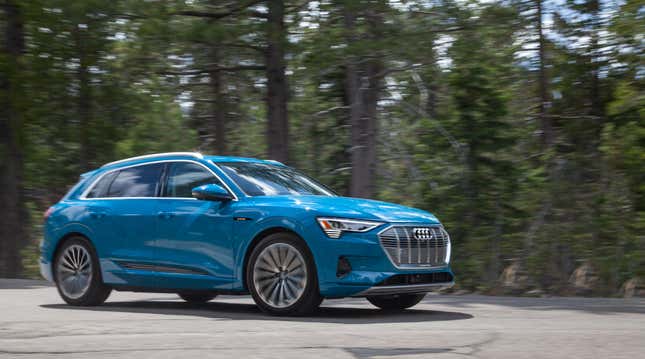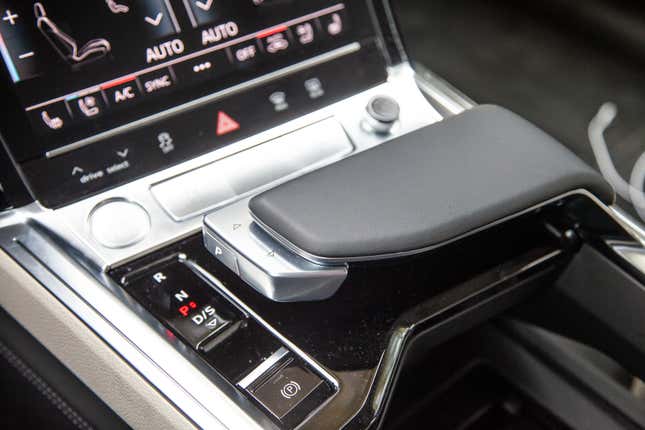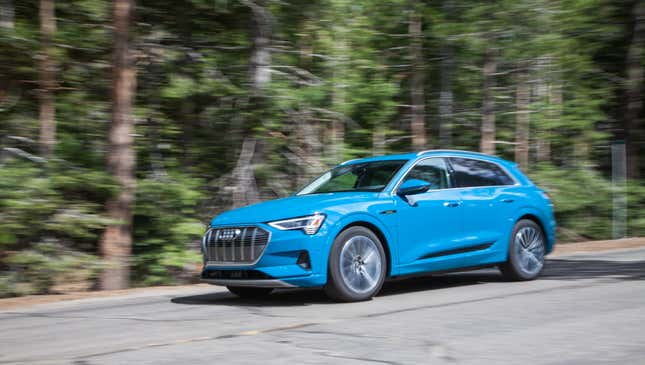It’s 2019 and the electric luxury car scene is finally starting to grow and diversify. The 2019 Audi E-Tron—Audi’s first fully electric mass-production vehicle—is the latest competitor to step in, offering the German automaker’s take on a plush and practical EV. Audi’s first effort here is solid, especially when it comes to charging speed, but it’s not any kind of “Tesla-killer” when it comes to range.
(Full Disclosure: Audi flew me to San Francisco then drove me to Napa. We wound up in Tahoe a day later, and Audi paid for my flights, hotels, food, and booze.)
There’s no such thing as the perfect vehicle. Sure, the Mercedes-Benz E63S wagon presents a strong argument, but you can always find trade-offs and compromises. Every car has them. It’s up to you to determine how much you’re willing to sacrifice with respect to your overall needs and wants.
For car shoppers eyeballing a new electric vehicle, additional trade-offs exist between overall driving range and how quickly you can get that range back on a recharge. Audi believes that people buying EVs today will care more about charging speed.
At least, to a point. The E-Tron applies that principle in a shape that should already be familiar to Audi’s main customers: it’s a stylish, fat wagon with a forward-thinking cabin space.
What Is It?
Architecturally, the E-Tron is a crossover that sits above the Q5 but below the Q7 and Q8. While the outside is familiar Audi in terms of its design language, it still manages to stand out a bit from the rest of the family–and it does so in a good way.
But without looking for the particularly opaque grille or futuristic chisel trim, the E-Tron blends in with every other Audi and actually looks pretty lowkey on the road with traffic. It’s a luxury crossover SUV that happens to be electric, not a bold statement of environmentalism getting shoved in the face of everybody the car silently sings by on the sidewalk.
It’s a car designed for urban people moving. Big enough to be practical, small enough to be manageable.
Specs That Matter
The E-Tron measures out to be about 193-inches long and 86.3-inches wide, putting its footprint right around the size of a Toyota Highlander. Well, if they chopped the roof a bit, and widened the stance. The length is bang on though.

Audi also says its electric car weighs a whopping 5,700 pounds, which is a lot more beef than a 5,307-pound standard range Tesla Model X or a 4,784-pound Jaguar I-Pace S.
But it’s no slouch–especially when you slide into Boost Mode. Put the E-Tron in Dynamic drive mode using the Drive Select system, push the accelerator to the mat, and when you’re past the kick-down point, the gauge cluster adds a Boost Mode around the speedometer. You now have 402 horsepower and 490 lb-ft of torque–enough to get this hefty hauler from 0-60 mph in a claimed 5.5 seconds.
It’s certainly not ludicrously fast (cough) but it feels plenty quick. Driving around more gingerly, the vehicle’s two electric motors powering the front and rear axles are supposed to be making a combined 355 horsepower and 415 pound-feet of torque. They get their power from a 95 kWh battery that weighs 1,500 pounds by itself. But at least the weight is down low, built into the bottom of the car like a skateboard.
What’s Great

Audi nailed the looks on this one. It’s as if a mighty god came down and saw what Bentley had done with its Bentayga, said “OH HELL-ITH NO!”, then used its divine powers to compress that luxo-SUV into a slightly more sleek fat wagon. Audi badges were applied, then everyone stood back and just nodded their heads.
The face is all electro-funk Audi, and the E-Tron wears the latest in LED lighting both front and rear. In fact, the side portion of the lighting elements are meant to mimic a graphic equalizer.
Why you ask? Because it relates to the sound... of silence. That’s according to those tasked with describing why every lump, bump, crease, or lighting element are shaped they way the are. Yes, design and marketing people can get a bit out there at times. Regardless of what it represents, it looks pretty sharp.
There’s enjoyable edge in the way the car moves, too. The battery pack keeps the center of gravity low while the standard air suspension keeps the ride comfortable. Audi’s engineers dialed in a perfect amount of heft to the steering, and Drive Select lets you adjust the overall demeanor a bit further. This is much more standard Audi driving than I would’ve initially guessed. Think much more A6 than Prius, thank god.
From the “auto” setting, if you switch to Off-Road mode, the E-Tron inflates itself up to gain two inches of ground clearance. Hammer along the highway in Dynamic mode, and it can drop an inch below the standard setting. Taking things a step further is the fact that the E-Tron is the first vehicle to utilize fully electric Quattro all-wheel-drive.
Audi’s people say it can meter out torque more precisely to put the power exactly where it needs to be. And apparently it monitors that output up to 1,000 times per second. I really want to push an E-Tron on a dirt road to see just how well electric Quattro behaves, but on road it felt as confident as the rest of the non-sporting members of the family.
The braking system is rather interesting, as well. When you initially step into the brakes, you’re actually slowing down using the rear motor, not the hydraulic brakes. You’re regenerating more juice this way. Additionally, the regen system is monitoring the car in front of you and pays attention to whether or not you should be slowing down, and using its rear engine to apply drag as necessary.
Brake harder and the hydraulic system will come in. The upside on this is that you get instant “braking” response as soon as you touch the pedal. It’s likely that it’s coming from the rear motor to start though, before you dive deeper into the pedal travel. What you feel in the cabin, however, is immediate and firm.

As with most new or updated Audi products, the interior is nicely refined and the E-Tron is outfitted with the latest in Audi’s MMI system. That means easy-to-read screens and as much or as little information displayed as you’d prefer.
There’s a new twist on the E-Tron, however, as the shift selector is now a static piece of the center console. A button on the end slides forward for reverse, back for drive, and has a well-placed button for park. It’s easy to use and lends a bit more style into an already well laid-out and designed space.
The biggest bonus on this E-Tron, however, is undoubtedly its charging speed. Outside of Tesla models, the E-Tron is the only other electric vehicle ready to accept e-juice at 150 kWh. That means it’s fast enough to net you around 54 miles of range in just 10 minutes of charging on a Level 3 DC Fast Charger rated to output at 150 kWh. On a system like that, you can reclaim 163 miles of range in around 30 minutes.
More DC Fast Charging stations are coming online too, as Volkswagen-owned Electrify America is increasing its station and charger count. In fact, anyone buying a new E-Tron will get a 1,000 kWh credit with Electrify America. Audi says that could take you up to 2,000 miles.
Charging on that network otherwise costs $1.00 to plug in, plus $0.30 to $0.35 per minute on a charge. You also get a $0.40 per minute “idle fee” if your car’s hooked up but not sapping power, to encourage people to shove off when their car’s topped up.
You’re not forced to exclusively use Volkswagen’s network, either–there are other EV charging options available and more seem to be popping up all the time.
Of course, the E-Tron is well-suited to home charging as well, as long as your garage outlet to be Level 2 ready. A 9.6 kW charger comes standard with the E-Tron. From 0 to 100 percent power full takes 9 hours using the at-home charger if it’s connected to 240 volts.
What’s Weak

The E-Tron needs to be a fast charger, because the other EV sticking point is overall driving range. Audi falls short of several competitors here, as the E-Tron’s EPA estimated range is just 204 miles.
That may be plenty of mileage for the average consumer on a daily basis, but it’s a number that can cause some anxiety in those currently considering a leap into first-time EV ownership. Americans tend to want cars that can do everything, from grocery runs to long trips. The range may scare people off here.
That’s especially true when Tesla touts much higher numbers. The standard range Model X nets 250 miles per the EPA. And the Jaguar I-Pace can make it a bit over 230 miles.

Regardless, Audi is quick to point out that its research showed “98 percent of all single-trip journeys in the U.S. are under 50 miles.” The Electrify America network is increasing on a weekly basis. And if you do undertake a long trip in an E-Tron, the navigation system will help you plot out charging stops. This includes how long you’ll need to charge at each stop to make it to the next one.
Early Verdict

The 2019 Audi E-Tron is a sharp-looking machine that serves up familiar Audi driving dynamics. It’s nice inside and out, comfortable and quiet on the road, and boasts some of the fastest charging options currently available.
It’s not cheap, but it’s a luxury car, so it doesn’t really need to be—the base Premium Plus starts at $74,800 while the top-tier Prestige trim is $81,800. That’s before Federal or state credits you might still be able to get, putting the E-Tron at a point more expensive than an I-Pace but a few grand less than a Model X (ignoring the wonky Tesla website math). And that feels appropriate for what it brings to the table.
For years, we’ve considered overall range to be the main talking point for electric vehicles. The conversation is shifting though, and now it seems like it might be more important to think in terms of miles per minute of charging. Smart EV consumers want to know how quickly they can get back on the road. With the E-Tron, the answer to that question is: “Very.”
Maybe the trade off between range and charging speed isn’t as dramatic as once thought.
My test drive took me from Napa Valley into Sacramento. There, we stopped for lunch and to let our machines charge up. It was a quick lunch, too, and I was back on the road in about 35 minutes or so. From there, I pointed the nose of the E-Tron towards Lake Tahoe and a lot of elevation. I wasn’t worried about range at any point along the way. My nav showed plenty of stations and I knew, if I needed more electricity, it wouldn’t take long to replenish the car’s power.
We’re nearly at the point where driving an electric vehicle is as boring as anything else... in a good way. Range anxiety is another step closer to being banished from our vernacular, and charging speeds are climbing higher. This is a good thing, and the Audi E-Tron plays an important part in advancing the practicality of high-end electric cars.
Correction: The Electrify America credit that comes with this car is in fact 1,000 kWh, not 1,000 kW as originally written.